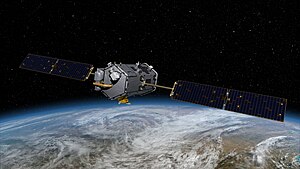Orbiting Carbon Observatory

Artist rendition of the OCO satellite as it would look in orbit
|
|
| Mission type | Climatology |
|---|---|
| Operator | NASA |
| Mission duration | Launch failure Planned: 2 years |
| Spacecraft properties | |
| Bus | LEOStar-2 |
| Manufacturer | Orbital Sciences |
| Launch mass | 530 kg (1,170 lb) |
| Payload mass | 150 kg (330 lb) |
| Dimensions | Stowed: 2.3 × 1.4 m (7.5 × 4.6 ft) |
| Power | 786 W |
| Start of mission | |
| Launch date | 24 February 2009, 09:20 UTC |
| Rocket | Taurus-XL 3110 |
| Launch site | Vandenberg LC-576E |
| Contractor | Orbital |
| Orbital parameters | |
| Reference system | Geocentric |
| Regime | Sun-synchronous |
 |
|
The Orbiting Carbon Observatory (OCO) is a NASA satellite mission intended to provide global space-based observations of atmospheric carbon dioxide (CO2). The original spacecraft was lost in a launch failure on 24 February 2009, when the payload fairing of the Taurus rocket which was carrying it failed to separate during ascent. The added mass of the fairing prevented the satellite from reaching orbit. It subsequently re-entered the atmosphere and crashed into the Indian Ocean near Antarctica. The replacement satellite, Orbiting Carbon Observatory 2, was launched 2 July 2014 aboard a Delta II rocket. The Orbiting Carbon Observatory 3, a stand-alone payload built from the spare OCO-2 flight instrument, will be installed on the International Space Station's Kibō Exposed Facility in December 2016.
OCO's measurements are designed to be accurate enough to show for the first time the geographic distribution of carbon dioxide sources and sinks on a regional scale. The data is planned to improve the understanding of the global carbon cycle, the natural processes and human activities that influence the abundance and distribution of the greenhouse gas. This improved understanding is expected to enable more reliable forecasts of future changes in the abundance and distribution of carbon dioxide in the atmosphere and the effect that these changes may have on Earth's climate.
...
Wikipedia
